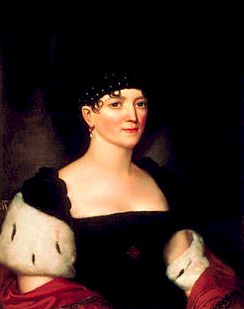|
 |

Part of the American
History & Genealogy Project |
Elizabeth (Kortright) Monroe 1768 ~ 1830


Elizabeth Kortright Monroe
Mrs. Elizabeth K. Monroe, nee Miss Elizabeth Kortright, was the
daughter of Captain Lawrence Kortright, a former captain in the
British army, who had remained in New York after the declaration
of peace in 1783, rearing and educating his family of one son
and four daughters. One of these daughters married Mr. Heyliger,
late Grand Chamberlain to the King of Denmark. Of the other two,
one married Mr. Knox, of New York, and the other was the wife of
Nicholas Gouverneur, of New York.
James Monroe was a senator from Virginia when New York was the
seat of government, and there met Miss Kortright, who is
described as tall, graceful and beautiful, with highly polished
manners. They were married in New York in 1786, during a session
of Congress. Soon after their marriage Philadelphia was chosen
as the Capital, Congress adjourning to that city. Senator Monroe
and his gifted wife took up their residence in that city. In
1794 he was appointed Envoy Extraordinary and Minister
Plenipotentiary to France. With the prestige of his position as
a senator and as a person of wealth and with Mrs. Monroe's
accomplishments, they were destined to represent their country
with great success.
It was while Mr. Monroe was American Minister to France that La
Fayette, who had so gallantly fought under Washington for
American independence, was taken prisoner by the Austrians and
transferred successively from the dungeons of Wesel, Magdeburg,
Glatz, Neisse and Olmutz, which differed only in forms of
cruelty and horrors which they inflicted upon the defender of
liberty in America. La Fayette, suffering in addition,
unspeakable mental torture over the knowledge of the
incarceration of Madame La Fayette and two of her innocent babes
in the prison of La Force, naturally appealed to the American
Minister.
The sympathies of Mr. and Mrs. Monroe were equally aroused for
their friends. Mr. Monroe determined that something must be
done, or that death would soon end the lives of these martyrs to
the cause of freedom. Fortunately, the star of destiny of
America was rapidly ascending, which enabled her representatives
to assume a loftier attitude in their demands for the
recognition of the rights of men. Mr. Monroe, intensely aroused,
made haste to try to relieve Marquis and Madame La Fayette. Mrs.
Monroe cooperated enthusiastically in the plans for their
relief, one of which was for Mrs. Monroe to visit Madame La
Fayette in prison. With a brave heart, she went to the prison,
and was successful in seeing Madame La Fayette, her inhuman
captors being afraid to refuse the request of Mrs. Monroe, who
was almost overcome with the wretched condition of that brave
lady when she was brought into her presence, supported by the
guards who watched her day and night. The day Mrs. Monroe called
Madame La Fayette had been expecting the summons to prepare for
her execution, and naturally was greatly alarmed when a gendarme
commanded her to follow him. More dead than alive, she was
ushered into the presence of her rescuer. After a few assuring
words of encouragement to Madame La Fayette, in tones loud
enough for those in her presence to hear, Mrs. Monroe assured
the unhappy woman that she would see her on the morrow. Mrs.
Monroe departed to speedily assist in the deliverance of her
persecuted friend, which was consummated next day. Madame La
Fayette left Paris under the protection of an American passport
to join her unhappy husband who, through the intervention of
George Washington and Napoleon Bonaparte, was also liberated. It
was subsequently learned that the very afternoon of Mrs.
Monroe's visit Madame La Fayette was to have been beheaded. To
the day of her death Mrs. Monroe regarded the saving of the life
of Madame La Fayette as her most gratifying achievement.
When Mr. Monroe was Governor of Virginia Mrs. Monroe presided
over the executive mansion with so much distinction that she won
great popularity. She was eminently fitted to fill the position
of First Lady of the Land when her husband succeeded James
Madison as President, after the War of 1812. The White House in
Washington was not what it is today, and Mrs. Monroe's health
was poor during their residence there, but one of their
pleasures was the entertaining of La Fayette, when he visited
the United States in 1824. Their youngest daughter, Maria, was
married in the East Room in March, 1820, to her cousin, Samuel
L. Gouverneur, of New York.
After the expiration of Mr. Monroe's eight years in the White
House, they retired to Oak Hill, their beautiful home, in Loudon
County, Virginia, where Mrs. Monroe continued her benevolence
and care of those dependent upon her and the unfortunates of the
community about them. She died suddenly in 1830, beloved by all
who knew her.
Women of
America

Source: The Part Taken by Women in
American History, By Mrs. John A. Logan, Published by The Perry-Nalle
Publishing Company, Wilmington, Delaware, 1912.
|